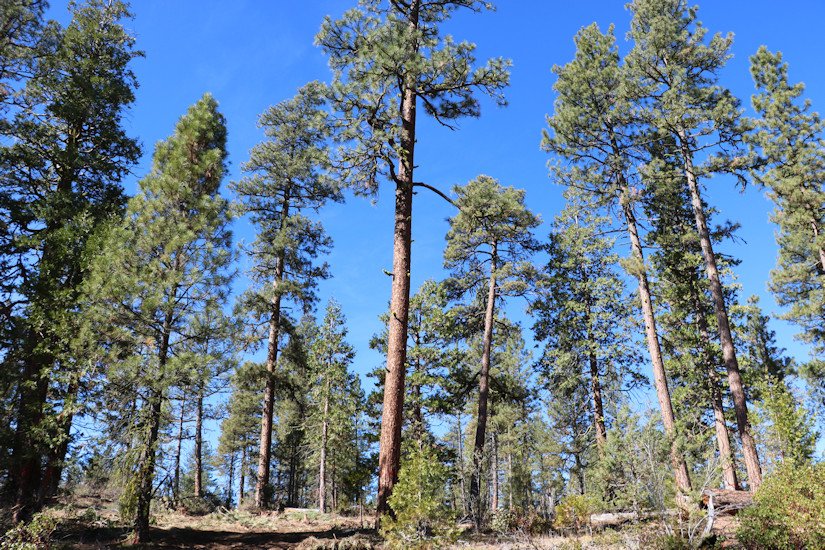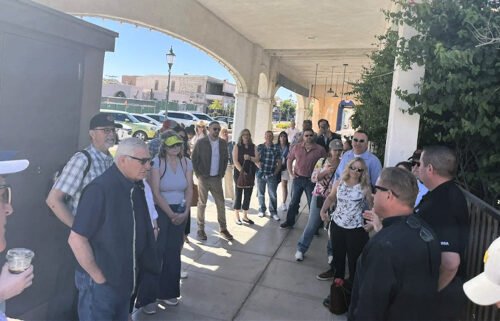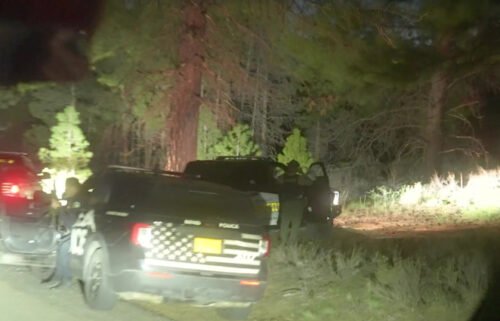ODF, ODFW, Forest Service renew agreement as conservation group sues to block logging of large trees

SALEM, Ore. (KTVZ) — The Oregon Department of Forestry, Oregon Department of Fish and Wildlife and U.S. Forest Service recently renewed their agreement allowing continued work across boundaries to reduce the risk of catastrophic wildfires, improve forest and watershed health, and create jobs in rural, forest-dependent communities. But lawsuits to block allegedly illegal logging of larger trees continue.
Earlier this month, the state and federal agencies' cooperative work agreement was extended until 2032 under the Good Neighbor Authority. That is a provision of the 2014 federal Farm Bill that allows state agencies to do vital restoration work on national forestlands in Oregon. Those make up nearly half of Oregon’s 30 million forested acres, according to a news release that continues below:
Kyle Sullivan with the Oregon Department of Forestry is that agency’s Federal Forest Restoration Program Lead. He said, “The Forest Service is the largest forestland manager in Oregon. We are seeing real benefit in leveraging the strengths, skills, and resources of state organizations tasked with stewarding Oregon’s forests, fish and wildlife. This Good Neighbor Authority agreement is a crucial tool to continue this cooperative work.”
Sullivan said ODF, ODFW and the Forest Service have been working together for over six years under the current GNA agreement. “We’ve identified long-term projects that extend beyond the agreement’s original 2026 expiration date. The agreement signed this week now extends the work between state and federal agencies through 2032,” he said.
The three state and federal land management agencies are taking aim at the most pressing issues facing Oregon’s forests. At the top of the list is the over 7 million acres of federal forest in declining health and at elevated risk of large and destructive wildfire. Climate change mitigation and adaptation, wildlife species recovery, habitat connectivity, producing sustainable forest products, and supporting jobs are also issues the GNA agreement can help address.
This GNA agreement allows the Forest Service to take advantage of the additional capacity provided by ODF and ODFW, access streamlined state contracting processes, and leverage state funding dedicated to restoring federal forests.
Despite the GNA agreement allowing states to help improve the health of federal forests, the agencies said all applicable federal laws and environmental reviews are followed. Decision-making authority still rests with the Forest Service for restoration work.
Forest Service Regional Forester Glenn Casamassa said, “GNA is a powerful tool. It allows us to work together across boundaries, at the appropriate scale, to benefit Oregon communities through enhancing forest and watershed health conditions – and to do so proactively, not reactively.”
Since 2016, ODF and ODFW have worked across all 11 National Forests in Oregon under 30 Supplemental Project Agreements. Results of this work include:
- 52,000 acres of restoration project planning and project preparation
- 11,000 acres of non-commercial fuels reduction and thinning, prescribed fire preparation, noxious weed treatments, wildlife habitat improvement, and stream enhancement
- 14,000 acres of commercial restoration, producing 50 million board feet of timber volume
- 7 contracted National Environmental Policy Act (NEPA) Categorical Exclusions (CE) projects covering 30,000 acres
- 440 acres of post-implementation monitoring work
In addition to the strong partnerships, the success of this work is also due to the Oregon Legislature’s forward-thinking investments in the Federal Forest Restoration Program. Under this program, state funds support forest collaboratives, environmental planning and analysis, and a state workforce dedicated to increasing the pace, scale and quality of restoration of federal forests.
“The renewal of this agreement maintains a crucial tool for the Oregon Department of Forestry to manage, protect and promote stewardship of all of Oregon’s forests,” said Oregon State Forester Cal Mukumoto. “Because so much of Oregon’s forests are under federal ownership, working with our federal partners under GNA is key to fulfilling the mission of ODF.”
Curt Melcher, Director of the Oregon Dept. of Fish and Wildlife, said, “As managers of Oregon’s fish and wildlife resources, we rely heavily on partnerships with public and private landowners to improve habitat. Formal agreements like this will further strengthen our partnership with the Forest Service and provide the flexible tools and resources needed to boost stewardship and bring rural communities together.”
Meanwhile, on October 6, the Blue Mountains Biodiversity Project filed suit against the Forest Service in U.S. District Court in Medford to stop what it alleges is the illegal logging of large trees on the South Warner project in the Lakeview District of the Fremont-Winema National Forest.
Here's the group's Monday news release, in full:
The Forest Service is planning to commercially log approximately 16,000 acres in the South Warner sale. The sale includes the logging of large trees, defined as those ≥21” diameter at breast height, with the agency relying on the illegal rollback of protections for large trees that took place during the final days of the Trump administration.
Previously, Forest Plans that guided management on National Forests in eastern Oregon and southeastern Washington prohibited logging of large trees in most circumstances. The prohibition was put into place in the mid-90’s because of the well-documented deficit of large trees across the landscape due to over-logging and mismanagement.
For over 25 years, the prohibition on logging large trees has been crucial for wildlife, water quality, and carbon storage. Numerous wildlife species depend on large trees and old forests for habitat, including American marten, Vaux’s swifts, Pileated woodpeckers, Black bears, numerous bird species, and bats. Large trees make up only 3% of the trees in these forests, yet store approximately 42% of the carbon.
In a rushed and illegal process that circumvented public participation, the Forest Service eliminated meaningful protections for large trees on approximately 11 million acres across six National Forests: the Deschutes, Ochoco, Malheur, Umatilla, Wallowa-Whitman, and Fremont-Winema National Forests. Over 115 scientists spoke out against the rollback of protections for large trees. Over 30 organizations, including wildlife, conservation, Indigenous, public health, and climate groups, raised concerns about the agency process and rule changes.
Included in the Trump-era changes to the previous protections is the change from an enforceable standard that clearly prohibited the logging of most large trees, to a discretionary guideline that focuses on retaining some old and large trees. Guidelines inherently provide more discretion to the agencies implementing them, ultimately making federal agencies like the Forest Service less accountable to the people whose forests they are required to protect and manage to provide habitat for all native species.
Blue Mountains Biodiversity Project’s (BMBP) legal challenge addresses both the Trump-era amendment to the Fremont-Winema Forest Plan as well as the South Warner project itself, which relies on that amendment to log large Grand and White fir trees up to 30” diameter at breast height. Public participation is a vital aspect of the Forest Plan amendment process under the National Forest Management Act, and the Service’s illegal circumvention of these requirements only serves to stymie the public’s right to comment on and object to the scientifically controversial management of their National Forests.
Blue Mountains Biodiversity Project’s Co-Director, Paula Hood expressed her disappointment regarding the South Warner project: “The Forest Service has a responsibility to protect large trees on the Fremont-Winema National Forest. The agency is instead targeting big trees for logging, despite overwhelming evidence that they are essential for maintaining biodiversity, providing clean water, and mitigating climate change. Large trees remain at a deficit on the landscape, and so every large tree out there is important right now. These biological legacy trees need to be protected, not logged.”
Tom Buchele, lead attorney on this case, stated that "the illegal amendment to the eastside National Forest Plans represents a last-ditch effort by the Trump administration to rush through the rollback of key protections for forests, without adequate public input or environmental review. We are suing the Forest Service to preserve ecologically-important large trees in this sale, and to defend the public's right to have a say in management on National Forests.”
Blue Mountains Biodiversity Project is represented by Tom Buchele at Earthrise Law Center and Austin Starnes, BMBP’s Staff Attorney.
Starnes said the illegal forest plan amendment this logging project relies on affects six National Forests in eastern Oregon and southeastern Washington.
"So we wanted to stress that, although this is a challenge to one timber sale on the Fremont-Winema, the consequences will be region-wide," he said.
BMBP is a grassroots ecological protection group based in Eastern Oregon that monitors and challenges agency actions in order to protect public lands on the Blue Mountains and Eastern Oregon Cascades.



